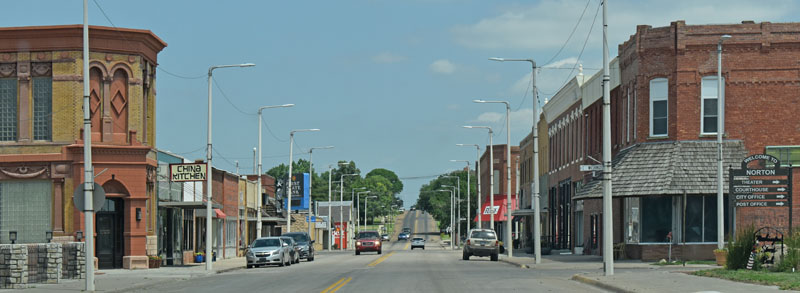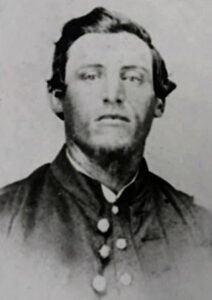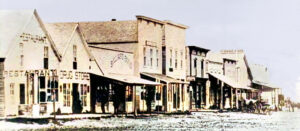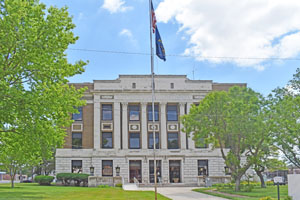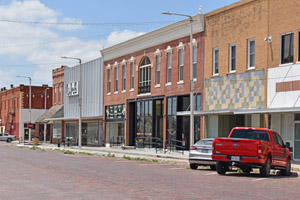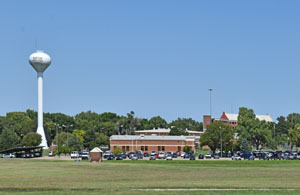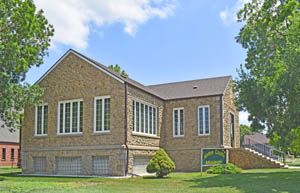Norton, Kansas, is the county seat and the largest city of Norton County. It is situated in the center of the county, on Prairie Dog Creek. As of the 2020 census, its population was 2,747, and its total area was 1.93 square miles, all land. The Nebraska border is 11 miles north of the city.
The Kansas Territorial Legislature, in 1859, had given the name Oro to the territory now comprising Norton County.
In 1867, an act was passed designating Norton as a county and defining its boundaries.
Norton’s history dates from the winter of 1870-71. Around this time, hunters and trappers reached Norton County, slowly moving westward along the streams. Others came seeking new homes, and still another class came to speculate, looking for easy money and office space. Among this class was N.H. Billings.
In February 1872, N.H. Billings came to the area from Cloud County and began preparations to establish a town and organize the county. He represented D.C. Coleman and Jim Hall, the only settlers in the area at that time, as the head of a syndicate of capitalists who would invest in building a city. Billings was a man of arrogant vanity and succeeded in having them perform the principal work, while he eagerly shared the profits.
Located within a mile or two of the county’s geographical center, the town was projected in the summer of 1872 by D.C. Coleman, L.J. Crans, and N.H. Billings, Samuel, and Edward Newell. The objective was to make it the county seat.
Coleman and the Newell Brothers began to erect a frame-store building. Logs were cut on the creek and sent to Kirwin, about 50 miles away, by ox teams, where they were made into lumber. This was the first frame house built in the county. The Newell Brothers put a stock of general merchandise in this building, the first store in the county. The town was first called Billingsville when a post office was established on June 10, 1872. W. Rawlins brought the first mail to Norton from Republican City, Nebraska, to the post office, which N.H Billings kept.
The town’s name was short-lived; it was renamed Norton on October 28, 1872. Like the county, it was named for Civil War soldier Orloff Norton, captain of Company L of the 15th Kansas Militia Infantry Regiment, who was killed at Cane Hill, Arkansas, in November 1864.
In December, the log house was sold to J.S. Briggs, who immediately moved it to the site of a new town that had started one mile up the river, leaving the stock of the Newell Brothers on the prairie. They made a temporary shelter with poles, hay trunks, and buffalo hides. The objective of the sudden removal was to leave the “claim” without a building, as required by law. To remedy this defect, a log house located six miles away was purchased the following day and relocated to the old site. The roof of the new house was made of buffalo hides. Within a week or two, a violent windstorm destroyed the frail tenement. The relics were gathered and reassembled, and the house was used as a church. A clergyman named Wainright was the first to preach a sermon in the building, the first public religious service in the county. Elder Gibbs afterward addressed the early settlers in the same place. This building was where Judge A.J. Banty held the first term of court in Norton County.
The first school district was formed in Norton in 1872.
James M. Maggard proved up on the land where the courthouse now stands in 1873. The first hotel was a log building constructed that year. That summer, John Cooper established other business establishments, including a drugstore. The townsite was platted on or sometime before July 17, 1873. On that date, the board rented a building from S.B. and E.M. Newell, measuring 12 by 20 feet, located on the northeast corner of the Public Square. The Norton Town Association began issuing deeds that year.
The Norton County Town Company charter was dated September 8, 1873. Richard Williams was President; George N. Kingsbury was Vice President; J.H. Simmons was Secretary; W.E. Case was Treasurer; Alva Smith, John O’Brien, and John De Mott acted with the President and Secretary as a Board of Directors. The first building erected after the organization of the Town Company was a residence for W.E. Case. The Norton Town Association promoted the town through advertising and land sales and encouraged the establishment of new enterprises within the city.
James M. Maggard sold approximately 60 acres to Richard Williams on September 26, 1873. The Norton Town Association began operating as a corporation in November 1873.
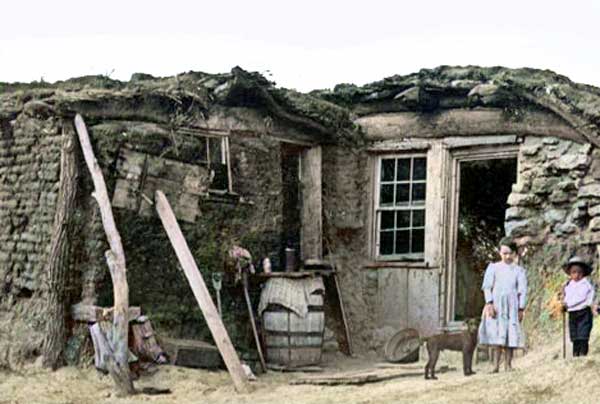
Norton County, Kansas Dugout, 1885.
The school was held in a dugout beginning December 1, 1873.
That year, Dr. Phoebe Amelia Oliver Briggs, along with her husband, John Story Briggs, a Native American, arrived in Norton. She practiced for eleven years before moving to Troy, Kansas, in 1884.
In the spring of 1874, Van Trump & Hallowell bought a stock of goods from Belleville and opened a store on the square built by David Close.
A Presbyterian congregation was founded in August 1874.
The Norton County Bee was established by Harmon & Baker in Norton on January 1, 1877. In November of the same year, the office was moved to Leoti, where it remained for a few months before returning to Norton. After publishing a few issues, the publication was discontinued.
In the spring of 1878, emigration increased, new buildings were erected, and new businesses opened. That year, Norton was declared the county seat, and the Newell brothers erected another building and leased it to the county for court and other purposes. The first officers of Norton were J.M. Price, Treasurer; W.H. Hopwood, Clerk; W. Louk, Trustee; Henry Oliver and S. Read, Justices; M. Wood and A. Wrager, Constables.
At that time, Norton had a saw and grist mill, a Presbyterian Church, a district school, two hotels, three lawyers, two doctors, two general stores, two blacksmiths, a hardware store, a shoe store, a cabinetmaker, a wagonmaker, a millinery, a builder, two drug stores, and a population of 150. It exported livestock and grain from Trego, the nearest railroad station, 60 miles away. It was on the stagecoach line to North Platte, Nebraska, and Hays weekly, and to Trego semi-weekly, from which the mail was delivered to W.B. Rogers, the postmaster.
The Norton County Advance was established at Norton in June 1878 by Pettigrew & Collins, publishers and proprietors. The paper was published until November 1882.
The title of the townsite remained in the name of Richard Williams until August 31, 1878. As president of the Company, he held the title in trust.
The Free Press was started at Norton on October 7, 1878, by Dr. A.A. Baker.
On March 1, 1880, there were over 7,000 inhabitants in the county and about 200 in Norton.
The Norton People, a seven-column folio, a Republican newspaper, was established by Hugh T. Carlisle on July 15, 1880. The newspaper soon had a good circulation and fair advertising patronage.
The school building, built of magnesian limestone, was a large two-story edifice located in a commanding position in the southern part of town. Completed in the winter of 1881, the structure cost $3,500, with E. Borin as principal.
The Norton Creamery, located one mile from town, was established in the spring of 1882 at a cost of nearly $2,000. Jesse Wright, J.B. Newell, and John Graves owned it. During the spring and summer months, it manufactured 250 pounds of butter daily. The creamery’s product was mainly shipped to Denver, Colorado.
The log hotel building was bought by George Griffin in 1884.
The town’s real growth began in 1885, when the Chicago, Burlington & Quincy Railroad was built through the county.
The Chicago, Rock Island & Pacific Railroad laid their tracks in 1887.
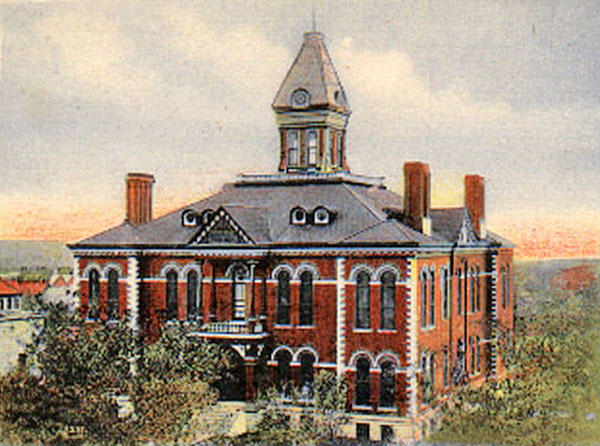
First courthouse in Norton County, Kansas.
From 1873 to 1889, there was no permanent courthouse building in Norton. Instead, various buildings were rented for county purposes. Bonds to build a courthouse failed to pass in 1887 and again early in 1888. A petition was presented requesting that an election be held to authorize $26,000 for the construction of a suitable courthouse for the county. The motion was granted, and an election was ordered for November 6, 1888. The vote was taken, and the bonds carried 1197 to 1029. The contract to build the courthouse was awarded to Kuhn and Waller of Norton, Kansas, for $24,875.
Dr. E.M. Turner opened the Sanitarium and Training School for Hospital Nurses in January 1900, and it was incorporated the following year, with Dr. E.M. Turner as president and Miss Hattie McClaury as secretary and treasurer. It occupied a large, imposing building equipped with the latest improved electrical and surgical instruments. It included an X-ray machine with a Crook’s tube attachment for examining the entire human system. Another feature was a hot-air vacuum used to treat rheumatism.
After 1900, the fair was held yearly in Elmwood Park in Norton.
In 1904, the first hotel, which George Griffin had purchased, was presented to the Norton women’s clubs, who moved it to Elmwood Park and began using it for social and literary meetings.
In 1905, Dr. William C. Lathrop arrived in Norton, Kansas. Initially, he treated patients in his home. He brought with him an X-ray machine and also performed various surgeries. His wife assisted him in his practice. In 1910, Dr. Lathrop rented the house next door and called it the “Cottage Hospital.” Drs. Lathrop, Kennedy, and Cole met with patients daily to care for their needs. Trained nurses supervised it.

A tornado in Norton, Kansas, in 1909.
Photographer Will Keller took one of the first recorded photographs of a tornado in Norton in 1909.
In 1910, Norton was an incorporated city of the third class and had grown into a bustling trade center. At that time it had an opera house, waterworks, an electric light plant, an ice plant, a flour mill, two grain elevators, a fire department, brick and tile works, telegraph and express offices, an international money order post office with five rural routes, was the seat of the county high school, and four newspapers — the Telegram, a daily and weekly, the Courier, the Champion, and the Norton County News, weeklies. It also boasted five general merchandise stores, two hotels, two milliner stores, two restaurants, five lawyers, two physicians, a harness shop, a furniture store, two livery stables, two blacksmiths, two banks, and a population of 1,787.
In 1911, Dr. Lathrop purchased a property to build a 20-patient hospital, which is now the Norton County Hospital. Additional lots were purchased over the next several years for expansion..
By 1919, the private Lathrop Hospital outgrew its quarters. A corporation composed of leading businessmen from Norton planned to construct a new addition that would care for 35 patients. The addition plans also established a nurses’ training building. Dr. Lathrop hired only registered nurses, but because they were scarce, he established a training school.
In 1922, the hospital was renamed Norton Methodist Hospital and Home for Nurses after the Methodist Episcopal Church Board of Hospitals purchased it. Dr. Lathrop, in addition to Drs. Funk and Jeffries were on staff. This year also marked the first commencement ceremonies of Lathrop Hospital Training School. There were five registered nursing graduates.
The courthouse was destroyed by fire on the night of December 1, 1926. Afterward, the county commissioners rented the American Legion building on the southeast corner of E. Main Street and S. Wabash Avenue. In August 1928, voters approved a bond issue to erect a new courthouse. Gurtler & Co. of Topeka, Kansas, was the general contractor. The total cost of the building, jail, and furnishings was $208,576. Move-in day was December 20, 1929. This building still serves the county.
On February 20, 1933, residents of Norton and Decatur Counties experienced a moderate earthquake. Buildings and houses swayed, and dishes and windows rattled. The earthquake occurred across a 6,000-square-mile area in Kansas and Nebraska.
In 1933, the hospital’s name was changed to Laird Memorial Hospital after Mr. John Laird and his wife, Mrs. Belle Whitney Laird, left a significant gift in memory of John, who had died the previous year.
In 1935, Dr. Lathrop took back the hospital from the M.E. Church Board of Hospitals through foreclosure proceedings. Three years later, Dr. Lathrop and his wife sold the property to the City of Norton Municipal Corporation. In 1939, the name was changed to Norton City Hospital.
Norton Junior High School was built in 1937 and extensively remodeled in 1984. It serves 7th- and 8th-grade students today.
In June 1950, a new hospital building was completed, and in subsequent years, it underwent several additions.
Eisenhower Elementary School was constructed in 1954 and underwent subsequent additions. Today, it serves students through the sixth grade.
Before the Bureau of Reclamation constructed Keith Sebelius Lake in 1963, Norton was prone to frequent flooding. The construction of the Dam has since resolved the problem and created the current reservoir, which lies 2.5 miles southwest of Norton.
Norton Community High School was constructed between 1975 and 1977.
By 1977, the Norton County Hospital had about 108 total employees.
In 1987, the Norton Correctional Facility was opened, with the first 24 minimum-custody inmates arriving. The facilities were previously used as a Tuberculosis Sanatorium, a State Hospital, and also as an Alcohol Treatment Center.
Today, the community is served by the Norton USD 211 public school district.
The Norton Downtown Historic District, covering 19 acres, includes 43 contributing buildings, a network of brick-paved streets, and 18 noncontributing properties. Preserving the downtown area began in 2008. A Kansas State Historical Society specialist introduced local officials to funding opportunities for the historical restoration of downtown buildings. In 2009, a grant covered approximately 60% of the cost of building restoration. The downtown area was listed as a Kansas State Historic Site in November 2010 and on the National Register of Historic Places in January 2011.
Individual buildings are mostly one- or two-story, architecturally one- or two-part commercial blocks. It includes the Norton County Courthouse built in 1929, a monumental building with six Corinthian fluted engaged columns on its east and west sides and six Corinthian fluted pilasters on its north and south sides; the Southwestern Bell Telephone Building (1956–1958), at 206 E. Lincoln Street, a two-story two-part commercial block which is “an excellent example of Modern Movement architecture in downtown Norton, including the city hall, post office, and more.
Since the area was designated a historic district, the local Chamber of Commerce estimates that over $6,595,000 has been invested in the restoration and rehabilitation of buildings, which has led to more businesses relocating to the district.
The Norton County Historical Museum at 103 E Lincoln Street features exhibits that showcase life in Norton County over the centuries, from fossils of the prehistoric past to one of the largest meteorites to hit North America to the life and booming businesses of Norton during the 1940s through the 1960s.
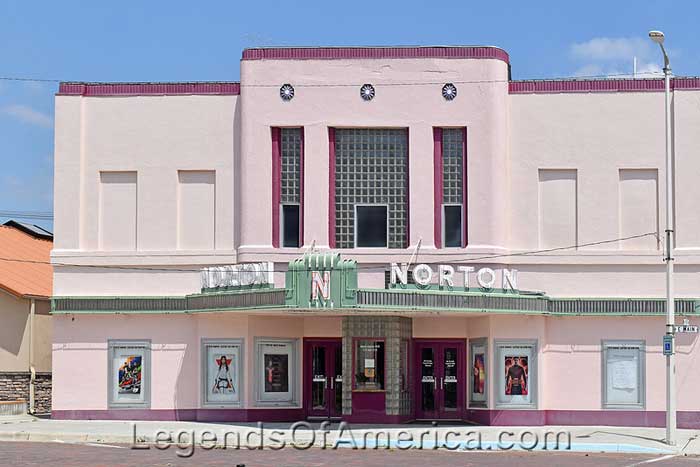
Norton Theatre opened in 1948. Today, much of the building remains largely unchanged, including the iconic front marquee. Photo by Kathy Alexander.
Also See:
Sources:
1878 Gazetteer and Business Directory, R.L. Polk & Co., Chicago, IL.
Blackmar, Frank W.; Kansas: A Cyclopedia of State History, Vol I; Standard Publishing Company, Chicago, IL 1912.
Cutler, William G.; History of Kansas; A. T. Andreas, Chicago, IL, 1883.
Fort Hays State University
Norton County Genealogy
Norton County Genealogical Society
Norton County Hospital
Norton County, Kansas
Western Resources Monthly Magazine, Number 130, Denver, Colorado, April 1901.
Wikipedia – Historic District
Wikipedia – Norton

